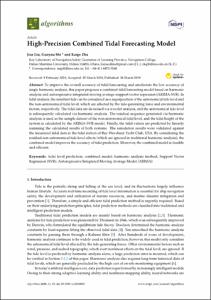| dc.contributor.author | Liu, Jiao | |
| dc.contributor.author | Shi, Guoyou | |
| dc.contributor.author | Zhu, Kaige | |
| dc.date.accessioned | 2021-12-15T11:23:07Z | |
| dc.date.available | 2021-12-15T11:23:07Z | |
| dc.date.issued | 2019 | |
| dc.identifier.citation | Liu, J., Shi, G. and Zhu, K. (2019) High-Precision Combined Tidal Forecasting Model. Algorithms. 12(3), pp.65-81. DOI: https://doi.org/10.3390/a12030065 | en_US |
| dc.identifier.uri | https://repository.oceanbestpractices.org/handle/11329/1807 | |
| dc.description.abstract | To improve the overall accuracy of tidal forecasting and ameliorate the low accuracy of
single harmonic analysis, this paper proposes a combined tidal forecasting model based on harmonic
analysis and autoregressive integrated moving average–support vector regression (ARIMA-SVR). In
tidal analysis, the resultant tide can be considered as a superposition of the astronomical tide level and
the non-astronomical tidal level, which are affected by the tide-generating force and environmental
factors, respectively. The tidal data are de-noised via wavelet analysis, and the astronomical tide level
is subsequently calculated via harmonic analysis. The residual sequence generated via harmonic
analysis is used as the sample dataset of the non-astronomical tidal level, and the tidal height of the
system is calculated by the ARIMA-SVR model. Finally, the tidal values are predicted by linearly
summing the calculated results of both systems. The simulation results were validated against
the measured tidal data at the tidal station of Bay Waveland Yacht Club, USA. By considering the
residual non-astronomical tide level effects (which are ignored in traditional harmonic analysis), the
combined model improves the accuracy of tidal prediction. Moreover, the combined model is feasible
and efficient. | en_US |
| dc.description.sponsorship | National Natural Science Foundation of China | |
| dc.language.iso | en | en_US |
| dc.rights | Attribution 4.0 International | * |
| dc.rights.uri | http://creativecommons.org/licenses/by/4.0/ | * |
| dc.subject.other | Tidal level prediction | |
| dc.subject.other | Combined model | |
| dc.subject.other | Harmonic analysis method | |
| dc.subject.other | Support Vector Regression (SVR) | |
| dc.subject.other | Autoregressive Integrated Moving Average Model (ARIMA) | |
| dc.title | High-Precision Combined Tidal Forecasting Model. | en_US |
| dc.type | Journal Contribution | en_US |
| dc.description.refereed | Refereed | en_US |
| dc.format.pagerange | pp.65-81 | en_US |
| dc.identifier.doi | 10.3390/a12030065 | |
| dc.subject.parameterDiscipline | Sea level | en_US |
| dc.bibliographicCitation.title | Algorithms | en_US |
| dc.bibliographicCitation.volume | 12 | en_US |
| dc.bibliographicCitation.issue | 3 | |
| dc.description.sdg | 14.a | en_US |
| dc.description.eov | Sea surface height | en_US |
| dc.description.adoption | Novel (no adoption outside originators) | en_US |
| dc.description.methodologyType | Method | en_US |
| obps.contact.contactname | Guoyou Shi | |
| obps.contact.contactemail | nsgi@dlmu.edu.cn | |
| obps.resourceurl.publisher | https://www.mdpi.com/1999-4893/12/3/65 | |
 Repository of community practices in Ocean Research, Applications and Data/Information Management
Repository of community practices in Ocean Research, Applications and Data/Information Management

